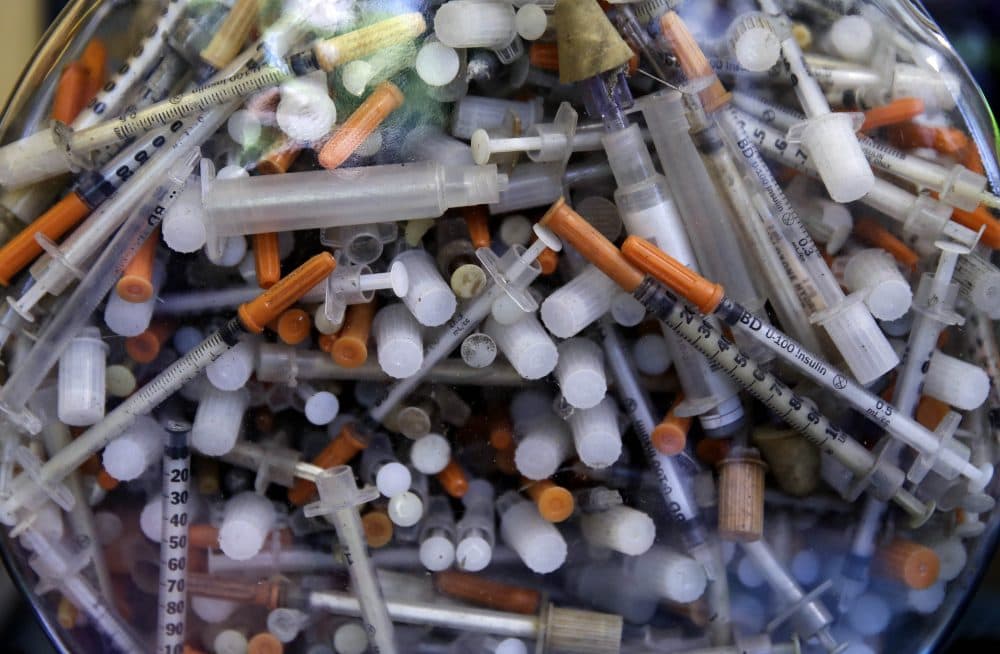Advertisement
Billions Of Dollars Lost To The Opioid Epidemic In Mass.
Resume
There are many ways to measure the devastating impact of opioid addiction in Massachusetts: rising numbers of babies born addicted to heroin, more emergency room visits and hospital stays, parks littered with needles and roughly six people who stop breathing during an overdose every day.
But there’s been little attention so far to what the epidemic is costing the state.
That may be, in part, because there are few, if any, state-specific estimates of the epidemic's impact on four main areas: health care, lost productivity, criminal justice and deaths.
But a breakdown of a seminal estimate from the Centers for Disease Control (CDC) suggests the state's economic burden was about $10 billion in 2016. For those lost to opioids, there's an additional cost based on the value of life that one economic model also puts at $10 billion in the same year.
The CDC found that opioid use, dependence and overdoses cost the U.S. $78.5 billion in 2013. That's a big number, but almost certainly underestimates current costs for two reasons.
First, because opioid deaths have risen dramatically since 2013. And second, because the $78.5 billion figure is based solely on the costs of addiction to prescription opioids. It does not include costs tied to heroin or fentanyl. The latter has become the leading cause of death in Ohio, Massachusetts and other states. The CDC is in the process of updating its economic burden assessment to reflect more recent addiction and overdose data, taking into account losses associated with street drugs.
"With those two combined I would expect the number to be larger, because it’s covering a larger range of potential problems," said Curtis Florence, lead health economist at the National Center for Injury Prevention and Control at the CDC.
In 2013, Massachusetts had 2.2 percent of the prescription overdose deaths, according to the CDC. So Massachusetts' share of the $78.5 billion figure could be in the range of $1.7 billion. Since then, overdose deaths in the state have risen more than six-fold, totaling 1,990. So the economic burden today has likely increased to at least $10 billion. That's still almost certainly a low-ball estimate because it does not factor in deaths from heroin or fentanyl.
In addition, new analysis suggests the opioid epidemic is taking a bigger bite out of labor productivity than previously projected.
Last year, Princeton University economist Alan Krueger published research that found almost half of prime working-age American men who’ve dropped out of the workforce take a daily pain medication. For about two-thirds of them, it's a prescription.
Krueger added another layer to that finding this fall. In a paper published by Brookings, with funding from the Federal Reserve Bank of Boston, Krueger links counties with the highest rates of men out of the workforce to those with the highest rates of opioid prescriptions.
"Over the last 15 years the spread of prescription opioid medication could account for possibly 20 percent of the decline in labor force participation," Krueger said.
He has not calculated the costs of this decline.
"But it does seem to be having a major macroeconomic effect on the U.S. economy," Krueger said.
Massachusetts does not have any counties with the highest overlap between opioid prescribing and a shrinking workforce. Neighboring New Hampshire and Maine do.
"But the prescription rates still have increased considerably in Massachusetts, and it's still substantially higher than was the case 10 or 15 years ago," Krueger said.
State leaders say it's important to understand all of ways the opioid epidemic takes a toll.
"But the big cost is the price that individuals and families pay, and the number of lives that have been lost over the course of the last decade," said Gov. Charlie Baker.
There is a model some economists use for calculating that loss. It’s called the value of a statistical life. It's used to weigh the pros and cons of raising the speed limit, for example, or changing pollution control rules. The value ranges from $4 million to more than $7 million.
Harvard Medical School associate professor Anupam Jena suggests using this model to evaluate the cost of overdose deaths in Massachusetts. If you multiply $5 million by 2,000, which is the approximate number of lives lost to an overdose in 2016, you get $10 billion.
"And if you look further back to 2010 to 2016 that number is about $40 billion," Jena said.
He suggests that these steeps tallies should guide spending on addiction prevention programs, treatment and other ways to reduce opioid overdose deaths.
"Because if the cost to the state of Massachusetts, per year, is $10 billion of lost welfare, $10 billion of lost happiness, then the state should be willing to spend $10 billion or more to combat the epidemic," Jena said. "That’s where that number really becomes relevant."
While these are sobering numbers, they still do not reflect the total economic toll of the opioid epidemic in Massachusetts.
"What about the children?" asked Dr. Laura Burke, an emergency room physician at Beth Israel Deaconess Medical Center.
Burke says seeing children come in to visit parents after an overdose or hearing stories of children finding a parent passed out, perhaps dead, have become common. She wonders how much the opioid epidemic will cost the next generation who may deal with post-traumatic stress disorder, depression and other physical health problems. One county in Ohio told Reuters its child services budget has nearly doubled in five years as children of parents addicted to opioids flood the system.
"A bad childhood has major ramifications," Burke said. "It worries me to think about what these children will deal with and the impact on society."
This article was originally published on September 21, 2017.
This segment aired on September 21, 2017.
